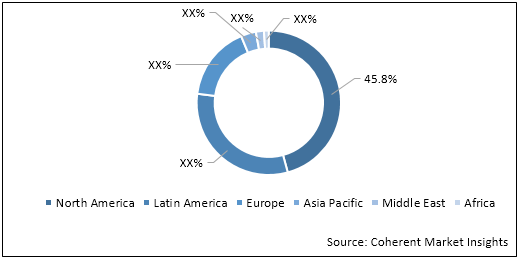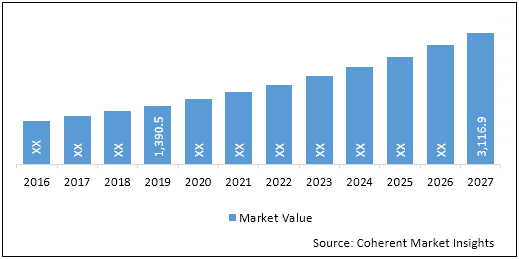Patient registry software (PRS) are computerized databases that contain personal, medical, social, and financial data which are being reported by healthcare professionals or by the patient. Registries can provide vital epidemiological data for rare or chronic diseases such as incidence and prevalence, symptoms, and severity of the disease to researchers and healthcare professionals.
The global patient registry software market is estimated to account for US$ 1,540.9 Mn in terms of value in 2020, and is expected to reach US$ 3,116.9 Mn by the end of 2027.
Global Patient Registry Software Market: Drivers
Increasing prevalence of cancer and other chronic disorders is expected to propel growth of the global patient registry software market over the forecast period. For instance, according to the American Cancer Society, in 2019, there will be an estimated 1,762,450 new cancer cases diagnosed and 606,880 cancer deaths in the U.S.
Moreover, PRS offers several advantages such as patient tracking, documentation of the history of diseases, its characteristics, management, and outcomes with or without any treatment, active surveillance system for the occurrence of unexpected or harmful events, and effective management of patient population. These advantages are expected to boost demand for PRS, thereby aiding in growth of the market.
North America held dominant position in the global patient registry software market in 2019, accounting for 45.8% share in terms of value, followed by Europe and Asia Pacific, respectively.
Figure 1. Global Patient Registry Software Market Share (%) Value, by Region, 2019

To learn more about this report, Download Free Sample
Global Patient Registry Software Market: Restraints
Issues such as unauthorized use, intrusion, data corruption, damage, fraud, and theft along with flawed medical expenses, incorrect data, insurance issues, and other discrepancies in the registry records are expected to hinder growth of the market.
Moreover, lack of healthcare IT professionals, especially in emerging economies is also expected to hinder growth of the market.
Global Patient Registry Software Market: Opportunities
Increasing adoption of Health 2.0 is expected to offer lucrative growth opportunities for players in the global patient registry software market. Health 2.0 can be defined as the use of web 2.0 or social media in healthcare. Healthcare organizations use online communities for disease management by offering patients 24/7 access to its peer communities.
Increasing number of clinical trials is also expected to aid in growth of the market. Clinical investigators and contract research organizations require patient information to recruit patients for clinical trials. According to the U.S. National Library of Medicine, the number of clinical trials conducted in the U.S. increased from 30,978 in 2018 to 32,523 in 2019.
The global patient registry software market was valued at US$ 1,390.5 Mn in 2019 and is forecast to reach a value of US$ 3,116.9 Mn by 2027 at a CAGR of 10.6% between 2020 and 2027.
Figure 2. Global Patient Registry Software Market Value (US$ Mn), and Y-o-Y Growth (%), 2019-2027

To learn more about this report, Download Free Sample
Market Trends/Key Takeaways
In Europe, increasing prevalence of diabetes is expected to boost demand for PRS. For instance, according to Diabetes UK, over five million people will suffer from diabetes in the U.K. by 2025.
Increasing adoption of mHealth services such as monitoring services, diagnostic services, preventive services, treatment services, research processes, emergency response services, and doctor assistance services, is also expected to aid in growth of the market.
Global Patient Registry Software Market: Competitive Landscape
Major players operating in the global patient registry software market include, Global Vision Technologies, Inc., Quintiles Inc., Dacima Software Inc., PatientCrossroads, Mckesson Corporation, Liaison Technologies, and Imagetrend, Inc. and Evado eClinical Solutions.
Global Patient Registry Software Market: Key Developments
Major players in the market are focused on adopting collaboration strategies to expand their product portfolio. For instance, in April 2020, Clara Health, a software startup, collaborated with Lyft, Inc., a ridesharing company, and VSC, a public relations agency, to build the registry platform and database to connect COVID-positive and -negative individuals with clinical trials for diagnostics, treatment and vaccine discovery.
Major players in the market are also focused on launching new products to expand their product portfolio. For instance, in March 2020, Health Catalyst, Inc., a provider of data and analytics technology and services, announced to launch a COVID-19 Registry, Dashboard, and Capacity Planning Tool.
Share
Share
Missing comfort of reading report in your local language? Find your preferred language :
Transform your Strategy with Exclusive Trending Reports :
Frequently Asked Questions
Select a License Type
Joining thousands of companies around the world committed to making the Excellent Business Solutions.
View All Our Clients